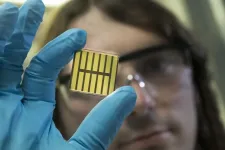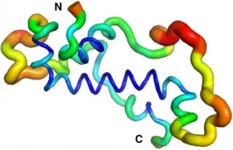New review explores effective sampling techniques for collecting airborne viruses and ultrafine part
2021-03-12
(Press-News.org) As the world continues to grapple with the COVID-19 pandemic, an international team of researchers have published a review of the best techniques to collect airborne aerosols containing viruses.
In the review, which was published by the Science of the Total Environment journal, a team led by the University of Surrey concluded that the most effective way to collect and detect airborne pathogens, particularly viruses, was to use cyclone sampling techniques.
For example, the sampler draws the air through the cyclone separator. It then uses centrifugal forces to collect the particles on a sterile cone containing the liquid collection vessel, such as DMEM (Dulbecco's minimal essential medium). The collected sample can then be readily used for any analysis for virus detection.
The research team hope that this wide-ranging review can serve as an information hub packed with the best methods and samplers involved in airborne virus collection.
The study is part of the INHALE project - an EPSRC funded project that aims to assess air pollution's impact on personal health in urban environments. The project involves Imperial College London, the University of Surrey and the University of Edinburgh.
The INHALE team also reviewed effective techniques for capturing fine (PM2.5) and ultrafine (PM0.1) particles to understand their toxicity and their role on reactive oxygen species in cells, their elemental composition and carbon content. The team also set out to find the best solution to prevent samples from being destroyed, a common problem found in toxicological experiments that makes large sample collection challenging. The study concluded that Harvard impactor samplers could be used for both indoor and outdoor environments to effectively collect these fine and ultrafine samples.
Professor Prashant Kumar, lead author of the study and Founding Director of the Global Centre for Clean Air Research at the University of Surrey, said: "The scientific community will have to become more efficient and resourceful if we are to overcome foes such as airborne viruses and air pollution. Knowing the right tools to use - as well as how and where to use them - is crucial in our ongoing fight to make the air we breathe cleaner and safer for all."
Professor Fan Chung, co-lead of INHALE from Imperial College London, said: "I am pleased that this timely review found support for the techniques that have been adopted in the INHALE research program. The collection of ultrafine particles is of particular importance because of the commonly found difficulties of collecting enough for toxicity studies. Ultimately, the success of INHALE will depend on the ability to capture enough of these fine and ultrafine particles as far as possible in their natural state."
Professor Chris Pain, co-lead of INHALE from Imperial College London, said: "Understanding the application of these sampling techniques is hugely important for environmental and health research in general and for the INHALE project itself, particularly concerning collecting ultra-fine particles."
INFORMATION:
Note to editors
This work was supported by the EPSRC INHALE (Health assessment across biological length scales for personal pollution exposure and its mitigation) project (EP/T003189/1).
References
Kumar, P., Kalaiarasan, G., Porter, A. E., Pinna, A., K?osowski, M. M., Demokritou, P., Chung, K. F., Pain, C., Arvind, D. K., Arcucci, R., Adcock, I. M., Dilliway, C., 2021. An overview of methods of fine and ultrafine particle collection for physicochemical characterisation and toxicity assessments. Science of the Total Environment 756, 143553. Link: https://v.2020.143553
ELSE PRESS RELEASES FROM THIS DATE:
2021-03-12
Photovoltaics decisively contributes to sustainable energy supply. The efficiency of solar cells in directly converting light energy into electrical energy depends on the material used. Metal-halide perovskites are considered very promising materials for solar cells of the next generation. With these semiconductors named after their special crystal structure, a considerable increase in efficiency was achieved in the past years. Meanwhile, perovskite solar cells have reached an efficiency of up to 25.5 percent, which is quite close to that of silicon ...
2021-03-12
Proteins are the key component in all modern forms of life. Haemoglobin, for example, transports the oxygen in our blood; photosynthesis proteins in the leaves of plants convert sunlight into energy; and fungal enzymes help us to brew beer and bake bread. Researchers have long been examining the question of how proteins mutate or come into existence in the course of millennia. That completely new proteins - and, with them, new properties - can emerge practically out of nothing, was inconceivable for decades, in line with what the Greek philosopher Parmenides said: "Nothing can emerge from nothing" (ex nihilo nihil fit). Working with colleagues from the USA and ...
2021-03-12
The Cabeza de los Gatos waste rock pile, left from mining activities in the town of Tharsis (Huelva), underwent a rehabilitation process consisting of remodelling the slope of the pile, applying liming materials and then a layer of soil. Finally, trees and shrubs typical of the area were planted and a hydroseeding with a mixture of shrub and herbaceous seeds was applied. Twelve years later, a study led by researchers from IRNAS-CSIC, in collaboration with Sabina Rossini Oliva, a researcher from the University of Seville and the Environment and Water Agency of Andalusia (AMAYA), has proven the effectiveness of this sort of rehabilitation.
"The results obtained show that the steps taken were successful. Now, ...
2021-03-12
People with high levels of emotional intelligence are less likely to be susceptible to 'fake news', according to research at the University of Strathclyde.
The study invited participants to read a series of news items on social media and to ascertain whether they were real or fictitious, briefly describing the reasons for their answers. They were also asked to complete a test to determine their levels of emotional intelligence (EQ or emotional quotient) and were asked a number of questions when considering the veracity of each news item.
Researchers found that those who identified the types of news correctly were most likely to score highly in the EQ tests. There was a similar correlation between correct identification and educational attainment.
The ...
2021-03-12
In asthma, the airways become hyperresponsive. Researchers from Uppsala University have found a new mechanism that contributes to, and explains, airway hyperresponsiveness. The results are published in the scientific journal Allergy.
Some 10 per cent of Sweden's population suffer from asthma. In asthmatics, the airways are hyperresponsive (overreactive) to various types of stimuli, such as cold air, physical exertion and chemicals. The airways become constricted, making breathing difficult.
To diagnose asthma, a "methacholine test" is commonly used to determine whether a person is showing signs of airway hyperresponsiveness. Methacholine binds to what are known as muscarinic receptors in the smooth muscle cells lining the inside ...
2021-03-12
The researchers say this is a big step in tackling smouldering peat fires, which are the largest fires on Earth. They ignite very easily, are notoriously difficult to put out, and release up to 100 times more carbon into the atmosphere than flaming fires, contributing to climate change.
The fires, known as 'zombie fires' for their ability to hide and smoulder underground and then reanimate as new flames days or weeks after the wildfire had been extinguished, are prevalent in regions like Southeast Asia, North America, and Siberia.
They are driven by the burning of soils rich in organic content like peat, which is a large natural reservoir of carbon. Worldwide, peat fires account for millions of tonnes of carbon released into the atmosphere each year.
Firefighters currently use millions ...
2021-03-12
A new model of aging takes into account not only genetics and environmental exposures but also the tiny changes that randomly arise at the cellular level.
University Professor Caleb Finch introduced the "Tripartite Phenotype of Aging" as a new conceptual model that addresses why lifespan varies so much, even among human identical twins who share the same genes. Only about 10 to 35 percent of longevity can be traced to genes inherited from our parents, Finch mentioned.
Finch authored the paper introducing the model with one of his former graduate students, Amin Haghani, who received his PhD in the Biology of Aging from the USC ...
2021-03-12
Researchers at Lund University in Sweden can now show that a new examination method identifies high-risk plaques in the blood vessels surrounding the heart, that cannot be seen solely with traditional angiograms. This type of plaque, rich in fat, could potentially cause recurring heart attacks in patients with heart disease. The study is published in the The Lancet.
"We have been working on this study for ten years. This creates a unique opportunity to treat plaques before they cause a heart attack", says David Erlinge, professor of cardiology at Lund University and Consultant in ...
2021-03-12
During 1995-2015, fullerene derivatives had been the dominating electron acceptors in organic solar cells (OSCs) owing to their performance superior to other acceptors. However, the drawbacks of fullerenes, such as weak visible absorption, limited tunability of electronic properties and morphological instability, restrict further development of OSCs toward higher efficiencies and practical applications. Therefore, the development of new acceptors beyond fullerenes is urgent in the field of OSCs.
Professor Zhan Xiaowei from the College of Engineering at Peking University is one of the pioneers engaging in development of nonfullerene acceptors in the world. ...
2021-03-12
University of Otago researchers have discovered one of the reasons why more than 50 per cent of people with type 2 diabetes die from heart disease.
And perhaps more significantly, they have found how to treat it.
Associate Professor Rajesh Katare, of the Department of Physiology, says it has been known that stem cells in the heart of diabetic patients are impaired. While stem cell therapy has proved effective in treating heart disease, it is not the case in diabetic hearts.
It has not been known why; until now.
It comes down to tiny molecules called microRNA which control gene expression.
"Based on the results of laboratory testing, ...
LAST 30 PRESS RELEASES:
[Press-News.org] New review explores effective sampling techniques for collecting airborne viruses and ultrafine part




